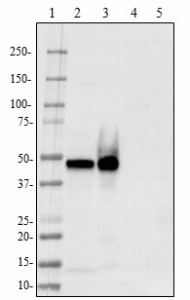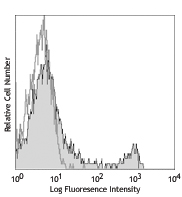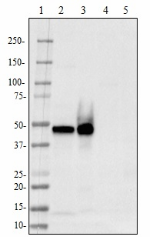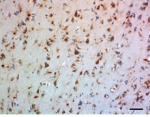- Clone
- 2E12 (See other available formats)
- Regulatory Status
- RUO
- Other Names
- Tripeptidyl Peptidase 1, Tripeptidyl Aminopeptidase, TPP-1, LPIC, Ceroid-Lipofuscinosis, Neuronal 2, Spinocerebellar Ataxia, Autosomal Recessive 7, Tripeptidyl-Peptidase 1, Tripeptidyl-Peptidase I, TPP I , SCAR7, GIG1
- Isotype
- Mouse IgG2b, κ
- Ave. Rating
- Submit a Review
- Product Citations
- publications

-

Western blot of purified anti-TPP1 antibody (clone 2E12). Lane 1: Molecular weight marker; Lane 2: 20 µg of human cerebellum lysate; Lane 3: 20 µg of human frontal cortex lysate; Lane 4: 20 µg of rat brain lysate; Lane 5: 20 µg of mouse brain lysate. The blot was incubated with 5 µg/mL of the primary antibody for 2 hours at room temperature, followed by incubation with HRP-labeled goat anti-mouse IgG (Cat. No. 405306). Enhanced chemiluminescence (Cat. No. 426302) was used as the detection system. -

IHC staining of purified anti-TPP1 antibody (clone 2E12) on formalin-fixed paraffin-embedded human brain tissue. Following antigen retrieval using Sodium Citrate H.I.E.R. (Cat. No. 928602), the tissue was incubated with 1 µg/mL of the primary antibody for 1 hour at room temperature. BioLegend’s Ultra Streptavidin HRP Detection Kit (Cat. No. 929901) was used for detection followed by hematoxylin and bluing solution counterstaining, according to the protocol provided. The image was captured with a 20X objective. Scale bar: 50 µm.
| Cat # | Size | Price | Quantity Check Availability | Save | ||
|---|---|---|---|---|---|---|
| 852201 | 25 µg | 112 CHF | ||||
| 852202 | 100 µg | 276 CHF | ||||
TPP1 is a member of the sedolisin family of serine proteases. The proenzyme is activated in the lysosome by auto-proteolysis where it cleaves tripeptides from the N-termini of substrates. Mutations of TPP1 are associated with late-infantile neuronal ceroid lipofuscinosis and Spinocerebellar Ataxia, Autosomal Recessive 7.
Product DetailsProduct Details
- Verified Reactivity
- Human
- Antibody Type
- Monoclonal
- Host Species
- Mouse
- Immunogen
- Recombinant mature human TPP1 expressed in E. coli.
- Formulation
- Phosphate-buffered solution, pH 7.2, containing 0.09% sodium azide.
- Preparation
- The antibody was purified by affinity chromatography.
- Concentration
- 0.5 mg/ml
- Storage & Handling
- The antibody solution should be stored undiluted between 2°C and 8°C.
- Application
-
WB - Quality tested
IHC-P - Verified - Recommended Usage
-
Each lot of this antibody is quality control tested by Western blotting. For Western blotting, the suggested use of this reagent is 1.0 - 5.0 µg per ml. For immunohistochemistry, a concentration range of 1.0 - 5.0 µg/ml is suggested. It is recommended that the reagent be titrated for optimal performance for each application.
- Application Notes
-
This clone does not recognize rodent (mouse or rat) TPP1.
-
Application References
(PubMed link indicates BioLegend citation) -
- Wujek P, et al. 2004. J. Biol. Chem. 279:12827-39.
- RRID
-
AB_2728589 (BioLegend Cat. No. 852201)
AB_2728589 (BioLegend Cat. No. 852202)
Antigen Details
- Structure
- Human TPP1 is a 563 amino acid protein with a molecular mass of 61 kD. An isoform of 34.5 kD and 320 amino acids (244-563) is generated by alternative splicing.
- Distribution
-
Tissue sources: Ubiquitously expressed. Highest levels in heart, placenta, bone marrow, lung, pineal, and lymphocytes.
Cellular distribution: Lysosome and extracellular. - Function
- TPP1 cleaves tripeptides from the N-termini of substrates in lysosomes and has endopeptidase activity.
- Interaction
- CLN5.
- Biology Area
- Cell Biology, Neurodegeneration, Neuroscience, Protein Misfolding and Aggregation
- Molecular Family
- Enzymes and Regulators, Proteases
- Antigen References
-
- Getty AL, Pearce DA. 2011. Cell Mol. Life Sci. 68:453-74.
- Cárcel-Trullols J, et al. 2015. Biochim. Biophys. Acta. 2242-55.
- Kyttälä A, et al. 2006. Biochim Biophys Acta. 920-33.
- Gene ID
- 1200 View all products for this Gene ID
- UniProt
- View information about TPP1 on UniProt.org
Related Pages & Pathways
Pages
Related FAQs
Other Formats
View All TPP1 Reagents Request Custom Conjugation| Description | Clone | Applications |
|---|---|---|
| Purified anti-TPP1 | 2E12 | WB,IHC-P,ICC |
Customers Also Purchased


Compare Data Across All Formats
This data display is provided for general comparisons between formats.
Your actual data may vary due to variations in samples, target cells, instruments and their settings, staining conditions, and other factors.
If you need assistance with selecting the best format contact our expert technical support team.

 Login / Register
Login / Register 









Follow Us